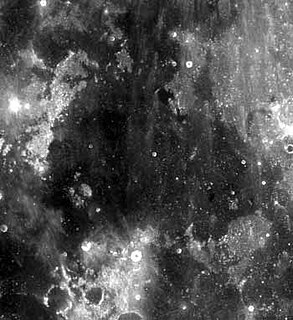
Mare Cognitum is a lunar mare located in a basin or large crater which sits in the second ring of Oceanus Procellarum. To the northwest of the mare is the Montes Riphaeus mountain range, part of the rim of the buried crater or basin containing the mare. Previously unnamed, the mare received its name in 1964 in reference to its selection as the target for the successful impact probe Ranger 7, the first American spacecraft to return closeup images of the Moon's surface.
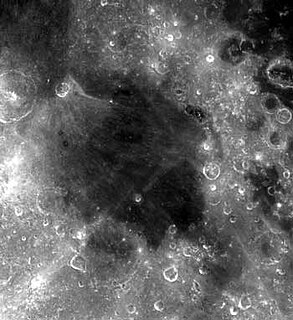
Mare Nectaris is a small lunar mare or sea located south of Mare Tranquillitatis southwest of Mare Fecunditatis, on the near side of the moon. Montes Pyrenaeus borders the mare to the east and Sinus Asperitatis fuses to its northwestern edge. It is 84,000 square kilometers in size.

Copernicus is a lunar impact crater located in eastern Oceanus Procellarum. It was named after the astronomer Nicolaus Copernicus. It typifies craters that formed during the Copernican period in that it has a prominent ray system. It may have been created by debris from the breakup of the parent body of asteroid 495 Eulalia 800 million years ago.

Aristarchus is a lunar impact crater that lies in the northwest part of the Moon's near side. It is considered the brightest of the large formations on the lunar surface, with an albedo nearly double that of most lunar features. The feature is bright enough to be visible to the naked eye, and displays unusually bright features when viewed through a large telescope. It is also readily identified when most of the lunar surface is illuminated by earthshine. The crater is deeper than the Grand Canyon.

Fra Mauro is the worn remnant of a walled lunar plain. It is part of the surrounding Fra Mauro formation, being located to the northeast of Mare Cognitum and southeast of Mare Insularum. Attached to the southern rim are the co-joined craters Bonpland and Parry, which intrude into the formation forming inward-bulging walls. The crater is named after Italian geographer Fra Mauro.

Euclides is a small lunar impact crater located near the eastern edge of Oceanus Procellarum, about 30 kilometers to the west of the Montes Riphaeus mountains. The mare in the vicinity is devoid of significant craters, but to the west is an area of low rises. The crater is named after the Greek mathematician Euclid.
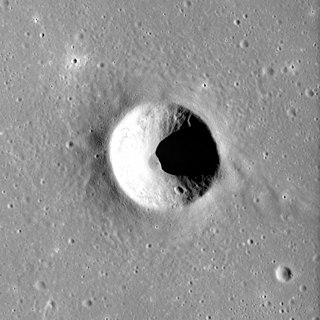
Kuiper is a small lunar impact crater in a relatively featureless part of the Mare Cognitum. It is a circular, cup-shaped feature with only some minor wear. It was named after Dutch-American astronomer Gerard Kuiper in 1976. Kuiper was the Project Scientist for the Ranger program. This crater was previously identified as Bonpland E. The lava-flooded crater Bonpland lies to the east at the edge of the Mare Cognitum.
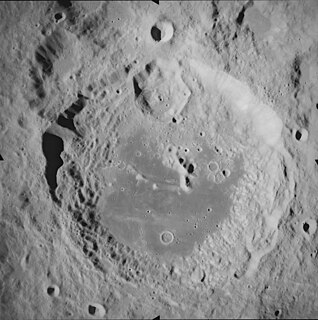
Aitken is a large lunar impact crater that lies on the far side of the Moon, named for Robert Grant Aitken, an American astronomer specializing in binary stellar systems. It is located to the southeast of the crater Heaviside, and north of the unusual formation Van de Graaff. Attached to the southwest rim is Vertregt. To the southeast is the smaller Bergstrand.

Taruntius is a lunar impact crater on the northwestern edge of Mare Fecunditatis. It was named after ancient Roman philosopher, mathematician and astrologer Lucius Tarutius Firmanus. To the northwest is the lava-flooded crater Lawrence, and to the north lie the craters Watts and da Vinci.

Bonpland is the remains of a lunar impact crater that is attached to the walled plain Fra Mauro to the north and Parry to the east. The intersection of their rims forms a three-pointed mountainous rise. To the southeast is the small crater Tolansky. Bonpland lies on the eastern edge of Mare Cognitum. It is named after Aimé Bonpland, a French explorer and botanist.

Vitello is a lunar impact crater that lies along the southern edge of the small Mare Humorum, in the southwest part of the Moon's near side. It was named after 13th century Polish theologian and physicist Vitello. It lies just to the east of the lava-flooded crater Lee. To the northeast along the edge of the lunar mare is the Rupes Kelvin, an irregular fault line.
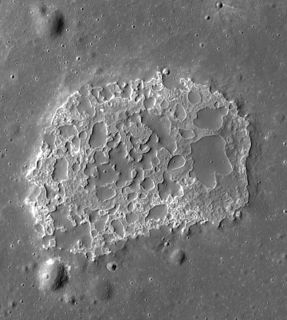
Ina is a peculiar small depression on the Moon, in Lacus Felicitatis. It is D-shaped, 2.9 km × 1.9 km wide and 64 m deep.

The geology of the Moon is quite different from that of Earth. The Moon lacks a true atmosphere, which eliminates erosion due to weather. It does not have any known form of plate tectonics, it has a lower gravity, and because of its small size, it cooled faster. The complex geomorphology of the lunar surface has been formed by a combination of processes, especially impact cratering and volcanism. The Moon is a differentiated body, with a crust, mantle, and core.

Cleopatra, initially called Cleopatra Patera, is an impact crater on Venus, in Maxwell Montes.

Hesperia Planum is a broad lava plain in the southern highlands of the planet Mars. The plain is notable for its moderate number of impact craters and abundant wrinkle ridges. It is also the location of the ancient volcano Tyrrhena Mons. The Hesperian time period on Mars is named after Hesperia Planum.
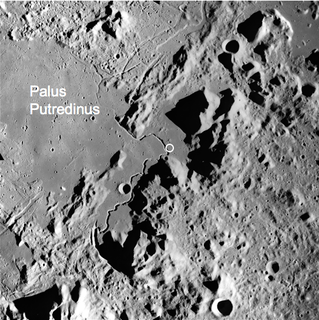
Hadley–Apennine is a region on the near side of Earth's Moon that served as the landing site for the American Apollo 15 mission, the fourth manned landing on the Moon and the first of the "J-missions", in July 1971. The site is located on the eastern edge of Mare Imbrium on a lava plain known as Palus Putredinis. Hadley–Apennine is bordered by the Montes Apenninus, a mountain range, and Hadley Rille, a meandering channel, on the east and west, respectively.
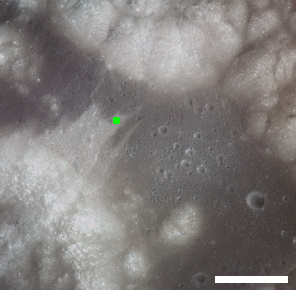
Shorty is a feature on Earth's Moon, an impact crater in the Taurus–Littrow valley. Astronauts Eugene Cernan and Harrison Schmitt visited it in 1972, on the Apollo 17 mission. It is the location of the famous "orange soil," which geologists believe to be small bits of rapidly-cooled molten rock ejected in a fire fountain. It is about 110 meters in diameter and up to 14 m (15 yd) deep.
Shorty Crater is about 14 m deep. Based on our investigations at the site and later examination of photographs, the impact that formed it penetrated, in order, regolith on the avalanche deposit, the avalanche deposit, regolith on a basalt flow, a basalt flow overlying and protecting the orange and black glass layers, the orange and black glass layers, regolith on a second basalt flow, and, finally, the upper portion of that second flow. Orange and black glass clods and basalt boulders are spread throughout the ejecta blanket surrounding Shorty.
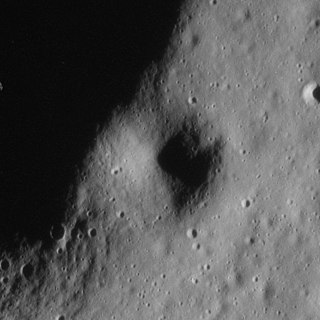
Elbow is a feature on Earth's Moon, a crater in the Hadley–Apennine region. Astronauts David Scott and James Irwin visited the east rim of it in 1971, on the Apollo 15 mission, during EVA 1. The east rim of Elbow was designated Geology Station 1 of the mission. Geology Station 2 was to the southwest of the crater, up the slope of Mons Hadley Delta.

Pierazzo is a small lunar impact crater on the far side of the Moon. It is located within the north-northwestern section of the immense skirt of ejecta that surrounds the Mare Orientale impact basin. To the south is the Montes Cordillera mountain ring. To the west is the crater Lents.

Volcanism on the Moon is represented by the presence of volcanoes, pyroclastic deposits and vast lava plains on the lunar surface. The volcanoes are typically in the form of small domes and cones that form large volcanic complexes and isolated edifices. Calderas, large-scale collapse features generally formed late in a volcanic eruptive episode, are exceptionally rare on the Moon. Lunar pyroclastic deposits are the result of lava fountain eruptions from volatile-laden basaltic magmas rapidly ascending from deep mantle sources and erupting as a spray of magma, forming tiny glass beads. However, pyroclastic deposits formed by less common non-basaltic explosive eruptions are also believed to exist on the Moon. Lunar lava plains cover large swaths of the Moon's surface and consist mainly of voluminous basaltic flows. They contain a number of volcanic features related to the cooling of lava, including lava tubes, rilles and wrinkle ridges.




















